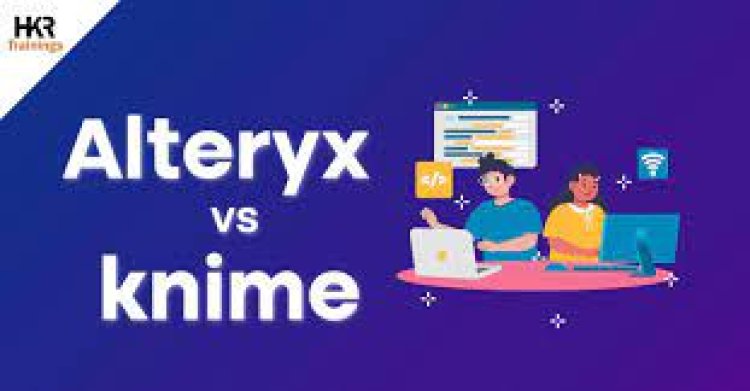KNIME vs Alteryx: Data science software comparison
In this article we are discussing about what is alteryx, what is knime, differences between alteryx vs knime, many more
Share this Post to earn Money ( Upto ₹100 per 1000 Views )

Data analytics is an indispensable part of modern businesses. It allows companies to make informed decisions and gain a competitive edge in their respective industries. With the proliferation of data, organizations need powerful tools to extract insights quickly and efficiently. This has led to the rise of several data analytics platforms, including Alteryx and Knime.
Alteryx and Knime are two popular data analytics platforms that offer a range of features for business users, analysts, and data scientists alike. Both platforms come with intuitive workflows that enable users to build complex data pipelines without coding knowledge. However, there are some fundamental differences between the two tools that might make one more suitable for certain use cases than the other.
What is KNIME?
KNIME (Konstanz Information Miner) is an open-source data analytics platform that allows users to visually build data workflows using a drag-and-drop interface. It provides a comprehensive set of tools for data integration, transformation, and analysis. KNIME supports various data types and offers a wide range of pre-built nodes for data manipulation and processing. It also provides advanced analytics capabilities, including machine learning and data mining algorithms. KNIME is highly extensible and allows users to create custom nodes using programming languages such as Java, Python, and R. It integrates with multiple data sources and analytics tools and has a large community that contributes extensions and workflows.
What is Alteryx?
Alteryx is a data analytics platform that provides tools for data preparation, blending, and advanced analytics. It offers a drag-and-drop interface for building workflows, making it accessible to users without extensive programming knowledge. Alteryx focuses on self-service data preparation, allowing users to clean, transform, and enrich data from various sources. It also includes predictive analytics capabilities, allowing users to build and deploy predictive models. Alteryx integrates with various data sources and provides connectors for popular tools like Tableau and Power BI. It has a user-friendly interface and provides a range of pre-built tools and functions for data manipulation and analysis..
Interested in learning Alteryx? Join HKR and Learn more about Alteryx Tool from the Alteryx Training!
Comparison of Features:
User Interface:
Alteryx: User-friendly drag-and-drop interface.
KNIME: Visual interface with a focus on customizable workflows and code-centric elements.
Data Integration and Preparation:
Alteryx: Strong focus on self-service data preparation with a wide range of tools.
KNIME: Robust data integration and preparation capabilities with extensive pre-built nodes.
Advanced Analytics and Machine Learning:
Alteryx: Built-in predictive analytics tools for building and deploying models.
KNIME: Extensive collection of machine learning and data mining algorithms with flexibility for customization.
Integration and Extensibility:
Alteryx: Seamless integration with various data sources and connectors for popular tools.
KNIME: Extensive integration capabilities and highly extensible with custom nodes and a large community of contributed extensions.
Community and Support:
Alteryx: Active community and support forums.
KNIME: Larger community and wider range of user-contributed extensions and workflows due to its open-source nature.
frequently asked AlterYX Interview questions and Answers !
Ease of Use: Comparison of User Interface:
Alteryx offers a user-friendly interface with a drag-and-drop workflow builder, making it accessible to users without extensive programming knowledge. The visual interface allows users to build data workflows by connecting pre-built tools and functions.
KNIME also provides a visual interface for building data workflows, but it leans more towards a code-centric approach. While it offers drag-and-drop functionality, it also allows users to customize workflows using programming languages such as Java, Python, and R.
In terms of ease of use, Alteryx's interface is generally considered more intuitive and beginner-friendly, especially for users without programming experience. KNIME's interface may appeal more to users with programming expertise who prefer more flexibility and control over their workflows.
Integration: Comparison of Third-Party Integrations:
Both Alteryx and KNIME offer integration capabilities with various data sources and analytics tools. Here's a comparison of their third-party integrations:
Alteryx integrates with a wide range of data sources, including databases, cloud platforms (such as Amazon Web Services and Microsoft Azure), and APIs. It also provides pre-built connectors for popular analytics and visualization tools like Tableau, Power BI, and Qlik.
KNIME also offers integration with various data sources and provides connectors for databases, cloud platforms, and APIs. It supports a broad range of analytics tools and libraries, including Python and R, allowing users to leverage their preferred tools within KNIME workflows.
Both platforms provide options for integrating with external systems, but Alteryx offers a more extensive list of pre-built connectors for popular tools and platforms.
We have the perfect professional AlterYX Tutorial for you. Enroll now!
Pricing: Comparison of Pricing Models:
The pricing models for Alteryx and KNIME differ, and it's important to consider your budget and specific needs when comparing them.
Alteryx follows a subscription-based pricing model. It offers different editions, including Alteryx Designer (for data preparation and analytics), Alteryx Server (for collaboration and automation), and Alteryx Analytics Gallery (for sharing and publishing workflows). The pricing varies based on the edition and the number of users.
KNIME, being an open-source platform, offers a free version called KNIME Analytics Platform, which provides a wide range of functionalities. It also offers a commercial version called KNIME Server, which provides additional features for team collaboration, automation, and deployment. The pricing for KNIME Server is based on a per-user or per-core model, and it varies depending on the deployment options and support level.
Conclusion:
In conclusion, Alteryx and Knime are both powerful tools that can help businesses make data-driven decisions. Alteryx is an ideal choice for organizations that need a user-friendly platform with robust data visualization capabilities. On the other hand, Knime offers greater flexibility in terms of customizability and extensibility, making it a great option for developers and tech-savvy teams. Ultimately, the choice between these two platforms will depend on your specific business needs and goals. Whichever tool you choose, it's important to prioritize ease of use, scalability, and integration with other tools in your tech stack.
To know more about the differences between Alteryx and Knime visit this blog Alteryx Vs Knime














